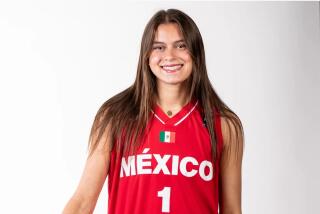Exporting Talent : Santa Margarita’s Mora Is One of Six Southern Californians Boosting Hopes of the Mexican National Women’s Soccer Team
- Share via
Susie Mora has always dreamed of playing for her country in international soccer competitions.
She just hadn’t figured, until recently, that the country would be Mexico.
Mora, 20, is a graduate of Santa Margarita who will begin her junior year at USC this fall. But when she takes the field Saturday in East Rutherford, N.J., she will do so as a member of the Mexican national women’s soccer team.
She is among 11 American-bred soccer players on Mexico’s 20-member team, which will be making its World Cup debut.
Indeed, the players wearing red, white and green uniforms have more ties to Southern California than the ones in red, white and blue.
The U.S. women’s team, which opens Saturday against Denmark in the first game of a doubleheader at Giants Stadium, features only three players from Southern California. The Mexican team, which plays Brazil in the second game, has six with Southern California connections.
Besides Mora, who grew up in Mission Viejo, there’s defender Barbara Almarez, who is transferring from Ventura College to USC this fall; midfielder Laurie Hill, a UC Santa Barbara graduate; goal-keeper Linnea Quinonez, from San Diego State; forward Gina Oceguera, who played for Cal Poly San Luis Obispo; and forward Monica Gerardo, from Simi Valley and Notre Dame.
Mexico’s head coach, Leonardo Cuellar, is the men’s and women’s soccer coach at Cal State Los Angeles. His assistant, Henry Sosa, coaches club soccer in San Diego.
To be eligible for Mexico’s national team, athletes must be Mexican citizens or possess dual citizenship. Besides those born in Mexico, citizenship may be granted to anyone who has at least one parent born in the country or has a grandparent born in the country, in which case both parent and child have to request citizenship.
Mora’s parents, Martha and Florencio, were born in Mexico.
Second Chance
Mora, born in Santa Ana, began playing soccer at 8, when her mother signed her up for AYSO.
“I always wanted to be in soccer,” her mother said, “but I could never play because girls were supposed to stay home.”
After moving with her family to Mission Viejo at age 12, Mora continued on to the club level as a member of the Mission Viejo Shamrocks, then at Santa Margarita High, where as a senior she helped the Eagles to their first of three consecutive Southern Section Division II championships, and finally at USC, where she has a soccer scholarship.
While in high school, Mora participated in the U.S. Olympic player development program and qualified for district and state teams. However, when she didn’t qualify for the regional team, she figured her dreams of playing in the Olympics or a World Cup were over.
That’s when Jim Millinder, her coach at USC, suggested she try out for Mexico’s national team, which had been looking north of the border for help.
“They have such great players in the U.S., I never thought I would have a chance [to make the U.S. national team],” Mora said. “But since I’m Mexican, that gives me a chance.”
Mexico has little chance of playing for the World Cup title July 10 in the Rose Bowl. Mexico isn’t expected to be among the two teams advancing out of Group B, which also includes Brazil, Germany and Italy.
Then again, 1 1/2 years ago, few people expected Mexico even to be a participant in the 1999 World Cup.
In 1997, when Sosa was hired as a full-time assistant, he joined a program trying to build a Cup contender from the ground up.
“They attempted to qualify in 1991 and 1995 and they were beaten soundly,” Sosa explained. “I mean soundly: 6-0, 7-1, 8-1. . . . They would get together three weeks before and try to qualify.”
Sosa said the Mexican soccer federation poured money into the women’s team, boosting its investment from about $11,000 per year to about $300,000.
“The hierarchy went from the old line to a progressive president, Enrique Borja, and a progressive vice president, Enrique Silva Teran, who agree with FIFA that the women’s game is important,” Sosa said.
Sosa’s job description included scouting talent, which meant a thorough search of Southern California.
“I looked in Texas and all around the country,” Sosa said, “but there just were a lot of talented players in Southern California. California is one of the hotbeds for soccer in the country.”
In a recent survey conducted by the Soccer Industry Council of America, California has 2.2 million soccer players, well ahead of second-place New York, which has 1.4 million players.
The 20-member U.S. team includes three players from Southern California: Julie Foudy of Mission Viejo, Joy Fawcett of Rancho Santa Margarita and Shannon MacMillan of Escondido.
Gaining Support
When Mora left to train with the Mexican team last summer, she had visions of free soccer equipment, clothes, shoes and. . . .
All kinds of other things that never materialized.
“I thought ‘Cool, I’m going to get all this gear and stuff,’ ” she said. “My friends are like, ‘Hook me up, Susie.’ ”
Instead, the team practiced in green T-shirts, with little other equipment provided besides soccer balls.
After training in San Diego from April to August, the team moved its practices to Mexico. While the Mexican American players were welcomed by their teammates, others were not so hospitable at first.
“The people who didn’t accept us right away were the Mexican people,” Mora said. “They would always say, ‘Send them away, we don’t want Americans.’ But they’re accepting us more now.”
With help from the Mexican American players, Mexico finished as CONCACAF runner-up, then defeated South American runner-up Argentina last December in a two-game playoff.
Still, Mexico doesn’t expect to challenge teams on the top rung of international women’s soccer.
“We can’t compete with the U.S. because we’re 20 or 24 years behind,” said Cuellar, who replaced Guillermo Monter as coach in November. “This is a brand new program.”
When Mora came aboard, she said the team was housed and fed, but that was about it. Only in the past few weeks have they been issued soccer shoes. For the most part, the players practiced with their own equipment while getting ready for the World Cup.
“When I first got to Mexico, I felt like I had been spoiled in the U.S.,” Almarez said.
Things are better since the team sewed up its World Cup berth. The players say they have seen a bigger commitment from Mexican governing bodies that previously ignored the team.
Training facilities in Mexico City, the same ones used for the Mexican men’s national teams, have been made available, and more support personnel has been assigned to the team. High-ranking officials from the federation that governs sports in Mexico plan to be in attendance at every World Cup game involving their team.
“Everyone was very cautious about doing things the right way,” said Cuellar, who played for Mexico in the 1978 World Cup.
Though the decision to recruit U.S.-born players might appear to be a quick fix, Cuellar said there is a commitment to field the best players of Mexican descent.
“If you are Mexican by law, the doors are open for anybody to play,” he said. “We won’t close the doors to Americans. Bringing in people like Susie was done for the purpose of promoting a sport in a country that hasn’t had good women’s soccer before.”
When the World Cup is over, Cuellar said he will meet with Mexican sports officials to work on developing under-20 and under-17 national teams, just like the men have.
As for Mora, she is thoroughly enjoying the opportunity to play for Mexico. Besides a couple trips she made to Tijuana with her family, she had been out of the United States only once, when she was a little girl. The time she has spent in Mexico in training has served as a cultural awakening.
“It’s such a learning experience,” she said. “My Spanish has gotten better, I listen to Spanish music now, and I’ve learned so many things about my culture that I didn’t know.”
She also has a warning to any opponents who might take Mexico lightly.
“Even though people think we’re underdogs, I think we’re going to be a surprise because we’re going to play with our hearts,” Mora said. “We have nothing to lose.”







